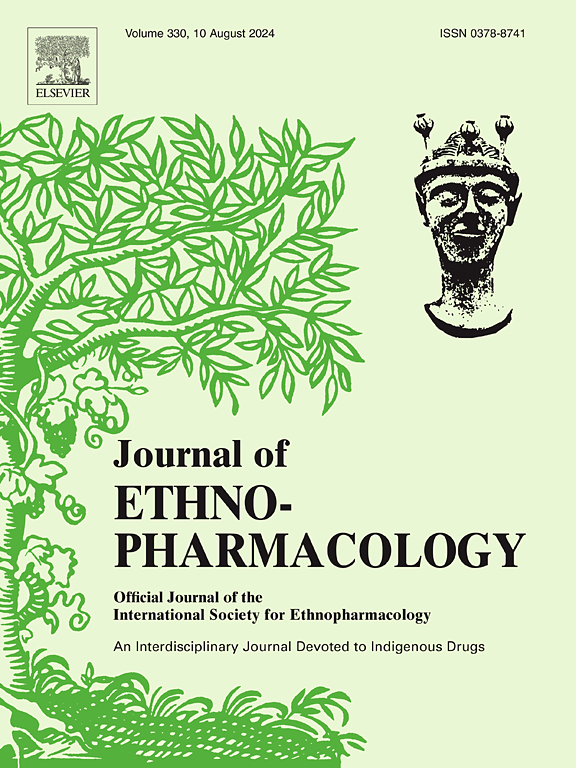结合代谢组学和网络药理学研究木劲散对乙醇性大鼠胃溃疡的预防作用。
IF 4.8
2区 医学
Q1 CHEMISTRY, MEDICINAL
引用次数: 0
摘要
民族药理学意义:胃溃疡(GU)是一种常见的多因素胃肠道疾病,影响着全球数百万人。清代吴谦在《益宗金鉴》中记载了一种著名的中药组合--木金粉。这一组合已被纳入治疗胃肠道疾病(尤其是 GU)的传统中医处方,并在现代医学研究中取得了显著效果。然而,马钱子对胃肠疾病的具体优势及其内在机制仍未得到充分了解,需要进一步研究:研究目的:评估 MJP 对乙醇诱导的胃黏膜损伤的预防作用,并阐明其潜在机制:本研究基于乙醇诱导的 SD 大鼠模型,以阐明 MJP 的药理作用。采用 UPLC-Q-TOF-MS 方法鉴定了 MJP 的化学成分以及治疗大鼠血清中被吸收的成分。应用血清代谢组学和网络药理学研究了MJP抗GU的潜在机制,并通过PCR和Western印迹分析验证了机制途径:体内药理实验表明,MJP能显著减少溃疡面积,改善胃组织的组织病理学特征。在 MJP 中检测到 53 种化学成分,并首次在治疗大鼠血清中检测到 18 种被吸收的成分。非靶向血清代谢组学发现了 28 种明显改变的差异代谢物,其中大部分都受到了 MJP 的调节和正常化。综合网络药理学和代谢组学分析表明,MJP 通过干预 5 个关键靶蛋白(PTG2、CHRNA7、CA1、PTG1、CASP3 和 AKT1)和调节差异代谢物发挥抗 GU 作用。PCR和Western印迹分析表明,木金粉可抑制PI3K/Akt/NF-κB通路,从而预防乙醇诱发的胃溃疡:结论:木金粉能有效改善乙醇诱导的大鼠胃溃疡,可能是通过抑制 PI3K/Akt/NF-κB 通路实现的。本文章由计算机程序翻译,如有差异,请以英文原文为准。

Integrating metabolomics and network pharmacology to investigate Mu Jin Powder prevents ethanol-induced gastric ulcer in rats
Ethnopharmacological relevance
Gastric ulcer (GU) is a common multifactorial gastrointestinal disorder, affecting millions of people worldwide. Mu Jin Powder (MJP), a renowned herbal pair, was recorded in Yizong Jinjian by Wu Qian during the Qing dynasty. This combination has been integrated into traditional Chinese medicine (TCM) prescriptions for gastrointestinal diseases, particularly GU, and has demonstrated significant results in modern medicine studies. However, the specific advantages of MJP for GU and its underlying mechanisms remain insufficiently understood, requiring further investigation.
Aim of the study
To assess the preventive effects of MJP on ethanol-induced gastric mucosal injury and elucidate its underlying mechanisms.
Materials and methods
This study was based on ethanol induced SD rat model to elucidate the pharmacological effects of MJP. The chemical components of MJP and the absorbed components in the serum of treated rats were identified by UPLC-Q-TOF-MS. Serum metabolomics and Network pharmacology were applied to investigate the potential mechanisms of MJP against GU, and the mechanistic pathways were verified through PCR and Western blot analyses.
Results
In vivo pharmacological experiments demonstrated that MJP significantly reduced ulcer area and improved the histopathological features of gastric tissues. Fifty-three chemical components were determined in MJP, and 18 absorbed components were detected in the serum of treated rats for the first time. Non-targeted serum metabolomics revealed 28 significantly altered differential metabolites, most of which were modulated and normalized by MJP. Comprehensive network pharmacology and metabolomics analyses indicated that MJP exerted anti-GU effects by intervening in 5 key target proteins (PTG2, CHRNA7, CA1, PTG1, CASP3, and AKT1) and regulating differential metabolites. PCR and Western blot analyses suggested that MJP may inhibit the PI3K/Akt/NF-κB pathway to prevent ethanol-induced gastric ulcers.
Conclusions
Mu Jin Powder effectively ameliorates ethanol-induced gastric ulcers in rats, potentially by inhibiting the PI3K/Akt/NF-κB pathway.
求助全文
通过发布文献求助,成功后即可免费获取论文全文。
去求助
来源期刊

Journal of ethnopharmacology
医学-全科医学与补充医学
CiteScore
10.30
自引率
5.60%
发文量
967
审稿时长
77 days
期刊介绍:
The Journal of Ethnopharmacology is dedicated to the exchange of information and understandings about people''s use of plants, fungi, animals, microorganisms and minerals and their biological and pharmacological effects based on the principles established through international conventions. Early people confronted with illness and disease, discovered a wealth of useful therapeutic agents in the plant and animal kingdoms. The empirical knowledge of these medicinal substances and their toxic potential was passed on by oral tradition and sometimes recorded in herbals and other texts on materia medica. Many valuable drugs of today (e.g., atropine, ephedrine, tubocurarine, digoxin, reserpine) came into use through the study of indigenous remedies. Chemists continue to use plant-derived drugs (e.g., morphine, taxol, physostigmine, quinidine, emetine) as prototypes in their attempts to develop more effective and less toxic medicinals.
 求助内容:
求助内容: 应助结果提醒方式:
应助结果提醒方式:


